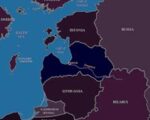The US Army has placed a new order for autonomous-capable Oshkosh Defense PLS A2 trucks as part of its push to modernize battlefield logistics and reduce risks to personnel in contested environments. These robotic trucks will support high-risk resupply missions using the Leader-Follower autonomy architecture.
Oshkosh PLS A2: Backbone of Robotic Resupply
The Palletized Load System (PLS) A2 is the latest iteration of the Army’s primary heavy tactical truck for distributing supplies across the battlefield. Designed and manufactured by Oshkosh Defense, the PLS A2 features an upgraded powertrain, improved suspension system, enhanced diagnostics capabilities, and is pre-configured for integration with autonomous systems.
Key specifications of the PLS A2 include:
- 10×10 configuration with all-wheel drive
- Payload capacity up to 16.5 tons (15 metric tonnes)
- CAT C15 engine producing over 600 hp
- Modular flatrack system compatible with ISO containers
- Autonomy-ready architecture supporting Leader-Follower kits
The system is optimized for rapid loading/unloading using its integrated Load Handling System (LHS), enabling it to deliver fuel, ammunition, food, or spare parts without requiring forklifts or cranes at forward operating bases.
Leader-Follower Autonomy: Reducing Risk in Contested Zones
The newly ordered trucks will be equipped with the Army’s “Leader-Follower” autonomy kit—a semi-autonomous convoy system developed under TARDEC (now GVSC) and tested extensively since 2018. In this configuration, a single human-driven lead vehicle guides a convoy of up to nine unmanned follower vehicles using sensors and V2V communications.
This approach mitigates exposure of soldiers to IEDs and ambushes during resupply missions in high-threat areas. The autonomy suite includes:
- LIDAR-based obstacle detection
- GPS/INS navigation with anti-jam capabilities
- 360° situational awareness via EO/IR cameras
- Vehicle-to-vehicle (V2V) mesh networking for convoy coordination
- Remote override and teleoperation fallback options
The Leader-Follower concept has undergone multiple operational evaluations at Fort Hood and Yuma Proving Ground under programs such as Expedient Leader Follower (ExLF) and Autonomous Ground Resupply (AGR). The technology reached Technology Readiness Level (TRL) 7+ by late FY2023.
A Step Toward Fully Autonomous Sustainment Chains
This procurement aligns with broader US Army objectives under its Robotic Combat Vehicle-Light (RCV-L) and Next Generation Combat Vehicle (NGCV) initiatives. While current systems are semi-autonomous with human oversight required at key decision points, future iterations aim for higher levels of autonomy—potentially enabling independent route planning and dynamic threat avoidance.
The Army’s Sustainment Automation Strategy envisions a phased transition from manned logistics convoys toward mixed-mode formations incorporating:
- Semi-autonomous tactical wheeled vehicles like PLS A2
- Unmanned aerial resupply drones for last-mile delivery
- MULE-class UGVs for intra-base distribution tasks
- AI-based predictive maintenance tools integrated into vehicle diagnostics systems
This transformation is designed not only to reduce casualties but also to increase tempo by enabling continuous resupply in denied or degraded environments where traditional convoys would be too vulnerable or slow.
Contract Details and Fielding Timeline
The latest contract was awarded under an existing multi-year framework agreement between the US Army TACOM Life Cycle Management Command and Oshkosh Defense. While financial terms were not disclosed publicly in the October announcement, previous orders have ranged between $100 million–$300 million depending on configuration counts and autonomy kits included.
The first batch of autonomous-capable PLS A2 trucks is expected to be delivered starting Q3 FY2025. Initial fielding will likely occur within select combat sustainment support battalions aligned with XVIII Airborne Corps or III Corps—units prioritized under Multi-Domain Operations doctrine due to their expeditionary role in Indo-Pacific or European theaters.
Operational Implications for Future Conflicts
The integration of robotic logistics platforms like the PLS A2 into frontline operations reflects a doctrinal shift toward survivability through dispersion and automation. In peer conflict scenarios—such as potential engagements against near-peer adversaries like China or Russia—rear-area security can no longer be assumed.
Sustainment units are increasingly expected to operate under threat from long-range fires, loitering munitions, cyber attacks on comms networks, or EW jamming. Autonomous trucks reduce both manpower requirements per mission and overall exposure time in high-risk corridors such as MSRs (Main Supply Routes).
“We need our sustainment formations to move faster than ever before—and do so without putting more soldiers at risk,” said Gen. Charles Hamilton, Commander of Army Materiel Command during a recent sustainment modernization forum.
If proven effective at scale during upcoming exercises such as Project Convergence or Defender Europe series events in FY2026–27, these robotic convoys could become standard elements within future Brigade Support Battalions (BSBs) across all active divisions.









